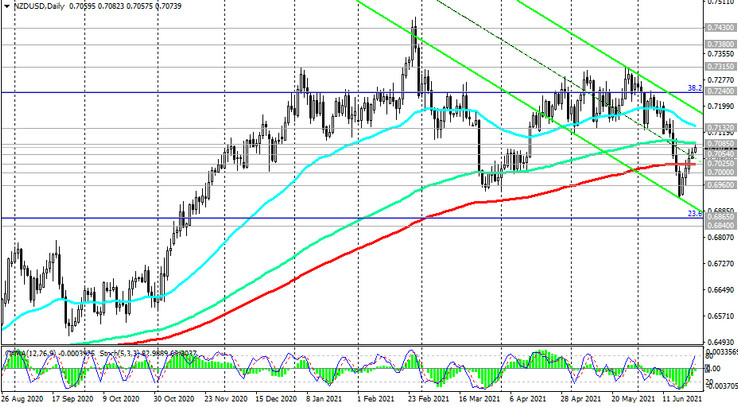Major commodity currencies are actively strengthening against the US dollar. Thus, the pairs Australian dollar/US dollar and New Zealand dollar/US dollar are showing growth today for the fifth trading session in a row.
The strengthening of commodity currencies comes amid renewed gains in global and US stock indices (the Dow Jones Industrial Average gained 300 points on Thursday, and the S&P 500 and the Nasdaq Composite reached record highs after US President Joe Biden announced a bipartisan agreement on new infrastructure projects for almost $ 1 trillion, and American banks successfully passed the Fed stress tests), commodity prices, as well as the weakening of the US dollar after Fed Chairman Jerome Powell noted in his recent speech that the central bank will not rush to tighten monetary policy based only on inflation data.
Other Fed officials have also already expressed support for Powell. For example, the President of the Federal Reserve Bank of New York, John Williams, on Thursday reiterated that he does not expect an interest rate hike anytime soon, given that the labor market has not yet returned to the form the central bank would like to see. As for the rate hike, “now is not the time for that because the economy is still far from full employment”, Williams said during his online speech. Answering the question about when the Fed may raise rates, Williams said that everything will depend on the development of the situation in the economy.
Thus, the Fed leaders reiterated that they are guided not only by inflation indicators, considering its active growth to be a temporary phenomenon. In their opinion, inflation, which exceeds the target level of 2%, may persist longer than previously expected.
Macroeconomic statistics from the USA also exert additional pressure on the US dollar. In particular, market participants on Thursday reacted negatively to the weaker-than-expected dynamics of orders for durable goods (in May, the number of such orders increased by 2.3% after declining by 0.8% in April and the forecast of +2.7%. At the same time, the number of orders excluding the defense and aviation sectors fell by 0.1%, despite the expected growth of 0.6%) and on the disappointing weekly data from the US labor market, also published on Thursday.
The number of initial applications for unemployment benefits for the week of June 18 fell by only 7 thousand to 411 thousand (the forecast assumed a stronger decline to 380 thousand).
Today, the focus of market participants will be the publication (at 12:30 GMT) of May statistics on the dynamics of personal income and expenses of US citizens and the updated consumer confidence index according to the University of Michigan (at 14:00 GMT).
If this data strengthens inflationary expectations and the likelihood of a tightening of the Fed's policy, then the US dollar may rise in the short term. In addition, the head of the Federal Reserve Bank of Boston, Eric Rosengren, is expected to speak at 17:00 (GMT). His comments on the Fed's monetary policy outlook could also add volatility to the dollar at the end of this last trading week of the month and the 1st half of the year. Next week will be a transitional week between June and July.
Returning to the dynamics of commodity currencies, in particular, the NZD / USD pair has been steadily developing positive dynamics since the beginning of this week, taking advantage of the stopped strengthening of the USD. At the time of this posting, NZD / USD is traded near 0.7072 mark, returning to the bull market and renewing highs since June 18th. After breaking through the resistance level 0.7085 (see Technical Analysis and Trading Recommendations), the next strong resistance at 0.7100 mark should be expected to be tested.






